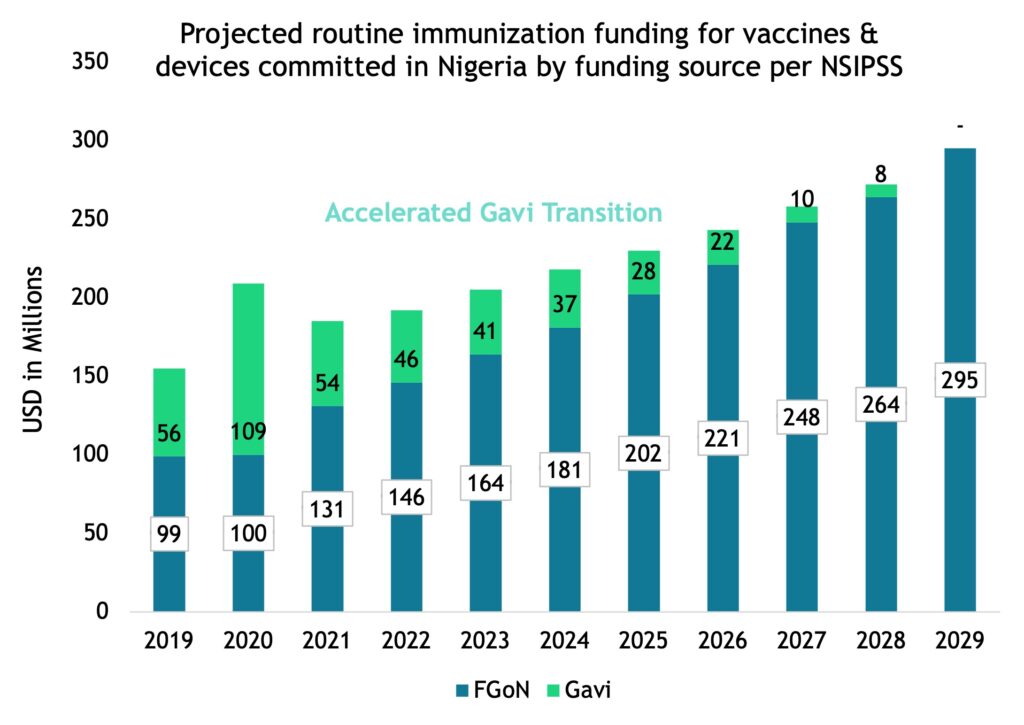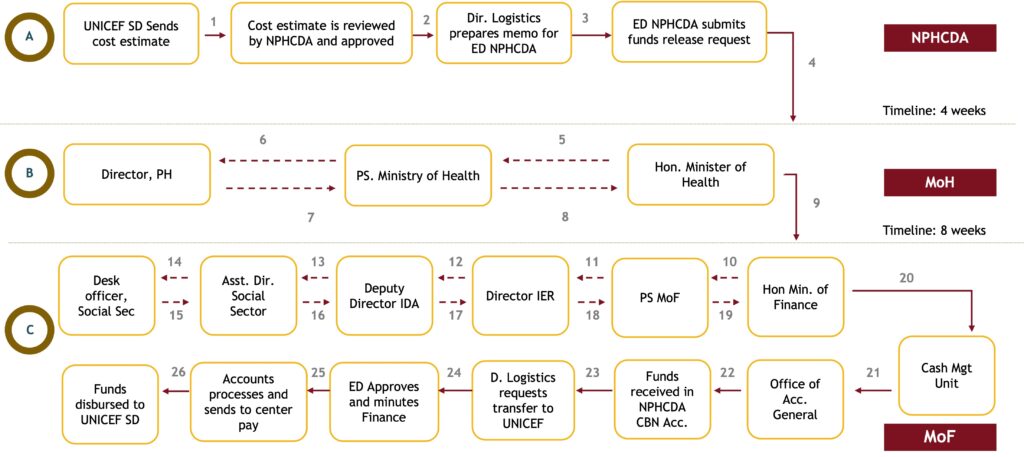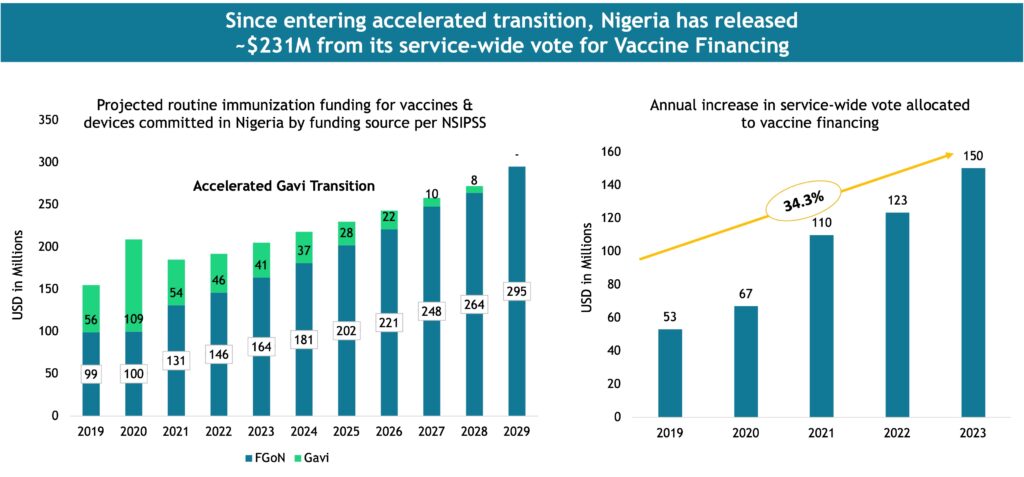A’ishatu, a mother of six children in Bauchi state, Nigeria, fully vaccinated her last child on August 16, 2023. She was first introduced to vaccination by a traditional birth attendant in 2016 when her first child was born.
In the last four years, the Nigerian government has worked diligently to ensure consistent, seamless, and equitable access to primary healthcare and immunization services to caregivers such as A’ishatu. In many low- and middle-income countries like Nigeria, donors and development partners are the cornerstone for funding for select primary care programs, including immunization services. However, this funding is typically not long-term, and conditional on the country eventually taking full ownership and responsibility for financing the supported health program. The Nigerian government has been making strides towards sustainable self-financing of its immunization services over the last few years. As the country moves away from its current reliance on Gavi support, the progress it has made thus far will stand as a robust foundation ensuring the continuity and accessibility of these vital services for people like A’ishatu.
Nigeria stands among the 73 Gavi implementing nations that have received support from Gavi for delivering immunization-related services. This assistance encompasses technical aid, campaigns, bolstering health systems, and acquiring cold chain supplies. Through Gavi financial support, Nigeria introduced life-saving vaccines such as the pneumococcal conjugate, inactivated poliovirus, pentavalent (PCV), rotavirus (RV), and human papillomavirus vaccines (HPV).

Figure 1: Nigeria Immunization program trajectory
Nigeria’s road to sustained self-financing
From 2016-2018, Nigeria’s Gross National Income (GNI) per capita exceeded US$1,580 for three consecutive years, leading it to surpass the Gavi’s support threshold. Resultantly, Nigeria was thrusted into the Gavi’s accelerated transition to self-financing phase. In response, Nigeria with support from CHAI and other partners and donors such as Gavi, BMGF, WHO, UNICEF, USAID, Solina, and Sydani begun to set up systems in place to prepare for sustained self-financing to ensure that caregivers like A’ishatu will continue to have access to all vaccinations children will need.
Road Map and Accountability Framework. The development of the Nigeria Strategy for Immunization and PHC System Strengthening (NSIPSS) was the initial step in preparing for the Gavi transition. Developed by the Federal Government of Nigeria (FGoN) in collaboration with CHAI and other technical partners and donors, the NSIPSS was approved by the Gavi Board in 2019. The main goal of this NSIPSS strategy was to increase FGoN’s investment in immunization and primary healthcare, as well as the overall health system. A prerequisite for approval of the NSIPSS by the Gavi Board was the development of an Accountability Framework (AF) to track the fulfillment of FGoN commitments annually. The accountability framework was backed by a Letter of Commitment from a tripartite allegiance of the Federal Ministry of Finance, the Federal Ministry of Health, and the Federal Ministry of Budget and National Planning. The AF was designed to include parameters that measure health financing, programmatic performance, financial management, and governance components with a total of 15 indicators to track the country’s performance.
Strengthening Domestic Financing. Prior to the transition, immunization activities were financed through loans and grants from donors such as Gavi and vaccine financing was not included in the national budget. To ensure caregivers such as A’ishatu continue to have access to vaccination during the transition, the Nigerian government needed to commence financing its vaccination and primary healthcare program through domestic resources. The government created a budget line for vaccine financing in the 2019 national budget under the service-wide vote (a centralized pool of funds managed by the Ministry of Budget and National Planning used for contingencies and critical areas of national interest) to fulfill its tripartite commitment per the NSIPSS. Since 2019, the country has continued to make an annual incremental provision for vaccine financing through a service-wide vote with a 34.2 percent increase between 2019 (US$60.7 million) and 2023 (US$148.1 million).[1] The government plans to build on this progress through the inclusion of vaccine financing as a first-line charge item on the national budget which is a more sustainable funding source as it will be a statutory allocation from consolidated revenue and the release will not be subject to bureaucratic delays.

Figure 2: Nigeria’s projected co-financing obligation until transition
Efficient Forecasting and a Financing Plan. The transition necessitated the need for accurate and effective forecasting reflecting the country’s needs. Nigeria has implemented several adjustments to the forecasts to expand capacity and institutionalize the process and make the projections as nearly precise as possible. For example, prior to the transition, the annual forecast was done at the national level, leading to incorrectly estimated demand at the state level. With technical support from CHAI and other partners such as UNICEF, this has been optimized and is now state-specific. In addition to transitioning to a state-specific forecast, the service-wide vote budgeting cycle needed to ensure the forecast is integrated into the national budget. Currently, the national logistics working group is tasked with forecasting the vaccines need by May of every year in time for submission to the budget office by July, when the budgeting cycle commences.
Upon conclusion of the forecast, the Vaccine Finance Plan (VFP) for financing the procurement of antigens and devices will be developed with the Federal Government of Nigeria and Gavi as the two principal funders. The VFP will see an annual decrease in Gavi’s commitment over the 10-year transition period with a corresponding increase in the Federal Government of Nigeria’s share. After the VFP is developed, it is approved by the ICC, the Ministers of Health, Finance and Budget, and National Planning. The amount allocated to the Federal Government is communicated to the budget office for inclusion in the National Budget.

Figure 3: Nigeria’s forecasting and budgeting timeline
Novel Tools for Visibility and Data use. To provide visibility and advocate for change, the vaccine distribution process needed to be clarified. The government with partners’ and MDAs support developed a comprehensive process map covering vaccine funding from forecasting through the final disbursement of funds for procurement from the UNICEF supply division. The process map was created to improve understanding of the vaccine financing process, draw attention to process bottlenecks, and encourage efficiency of the vaccine financing process.

Figure 4: Nigeria’s Vaccine Fund request process map
Developing a Multi-Sectoral Approach. Stakeholders at all levels have been crucial to Nigeria’s efforts to finance immunization activities sustainably. The Vaccine Finance and Accountability Task Team (VFATT), constituting traditional and non-traditional stakeholders, has been set up with an overarching goal of ensuring efficient and sustainable vaccine financing over the Gavi transition period. It was also tasked with ensuring that Nigeria consistently meets the agreed targets for all the indicators on the Accountability Framework for the NSIPSS. The roles and responsibilities of the task team include, monitoring the progress of implementation of the approved NSIPSS Accountability Framework, tracking immunization funds and vaccine utilization, developing the annual vaccine financing (VF) plan, and strengthening advocacy for immunization and primary healthcare financing. The task team meets monthly to discuss funds budgeting, disbursement, utilization, and the status of the AF indicators. The task team plays an important role in proffering solutions to immunization financing challenges and ensuring that the country meets its co-financing obligation.
A Call to Action. The government of Nigeria has made immunization and PHC financing a priority since 2018 and through strong advocacy and political commitment, increased its co-financing for immunization by 34.2 percent.[2] The result has been the institutionalization and resiliency of immunization self-financing. However, the financial stability of immunization activities remains uncertain in the face of a constrained fiscal policy and the need for newer vaccines. Gavi reported that out of the 19 countries that have transitioned as of 2022, 13 have not yet introduced at least one of pneumococcal conjugate, rotavirus, or human papillomavirus vaccines.[3]

Figure 5: Nigeria analysis of fund released since transition
To retain the immunization gains achieved over the years and continue the introduction of new vaccines post Gavi support, the government needs to ensure:
- timely targeted high-level stakeholder engagement
- quantification and forecasting
- advocacy and political commitment
- enhanced and sustainable financing
- the continuous tracking of the accountability framework
For other countries heading toward transition, there is a need for strong collaboration and alignment between the country’s financial decision-makers and the EPI stakeholders/ministries of health. This can be achieved through continuous advocacy and the identification of a champion amongst lawmakers. Several tools and processes can aid advocacy, however, a key lesson for sustainability is that this process should be government-owned and led.
*Name changed to protect anonymity.
[1] Financial Analysis from Nigeria’s Medium-Term Framework 2019 – 2023. Exchange rate used: 2019 ($1/350); 2023 ($1/470).
[2] CHAI Financial Analysis
[3] https://www.gavi.org/types-support/sustainability/gavi-mics-approach





